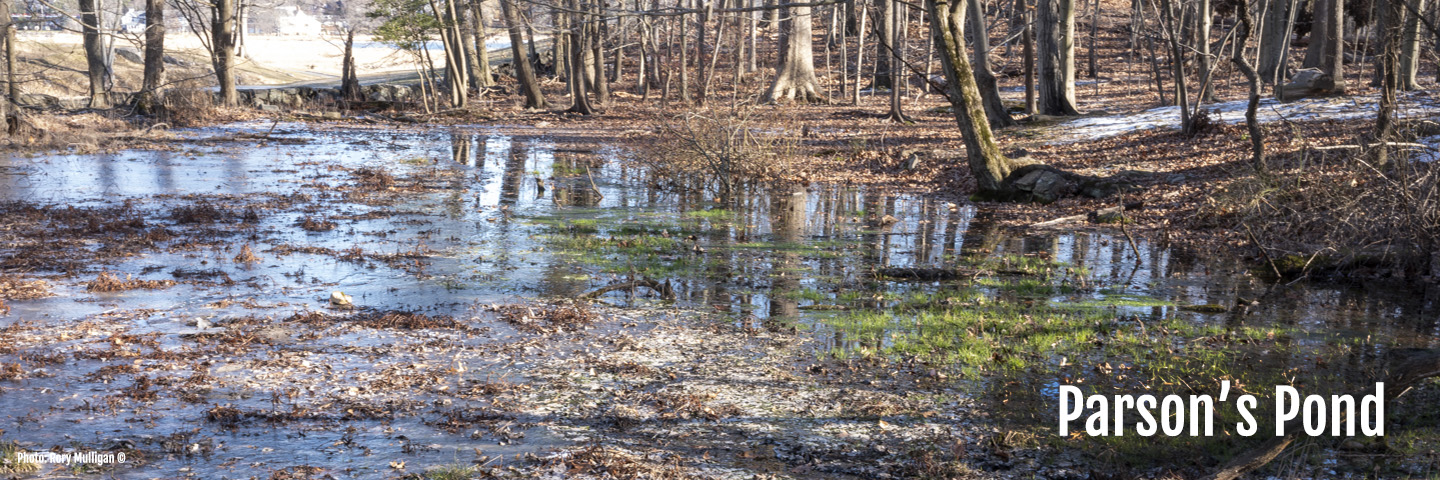A Pond is a Freshwater Habitat, Where Life Depends on Green Plants for Existence
The conservancy is home to two spring-fed ponds, both of which were man-made but now support aquatic life. Common duck weed (Lemna minor) is a green plant that grows in great profusion in these freshwater ponds. It converts sunlight into food and is the base of the aquatic food chain. Green plants add oxygen to the water and provide shelter for young creatures and protection from many predators. Pond plants have special adaptations for living in freshwater, including flexible, central stems that bend with the current or waves. Aquatic plants are surrounded by water that contains dissolved nutrients. Their leaves and stems are able to absorb these nutrients directly from the water, reducing the need for the elaborate root systems that land plants have. Pond plants have specially shaped leaves to absorb the carbon dioxide needed for photosynthesis. Some submerged plants protect themselves by producing a covering of mucous to discourage animals from eating the soft tissue underneath and to shield stems when the current causes the plants to rub against each other. Parson’s Pond is on the eastern border of the conservancy and was created in the 1800’s as an ice pond for the Parsons family.
 Photo: ©Michael Gambino
Photo: ©Michael GambinoGreen frogs (Lithobates clamitans) live in and around Parson's Pond
 Photo: Wikipedia
Photo: WikipediaNorthern spring peepers, (Pseudacris crucifer crucifer) visit this freshwater pond in the spring to mate and lay eggs
Like Other Freshwater Ponds, Parson’s Pond is a Critical Habitat for Amphibians
During spring migrations, many different amphibians move from the forests to woodland pools to breed. In spring at Parson’s Pond, an urgent and sometimes deafening chorus can be heard from the small spring peeper (Pseudacris crucifer crucifer), northern green frog (Lithobates clamitans), and the very large bullfrog (Lithobates catesbeianus). All join in the chorus to be heard, to attract a mate, and fertilize their eggs.1 Also here live a common snapping turtle (Chelydra) and an elusive family of muskrat (Ondatra zibethicus). The pond contains the juvenile stages of many insect species. Duckweed (Lemna minor) is an important high-protein food source for waterfowl and provides shelter for fish. It is also significant in the process of bioremediation because the plant grows rapidly, absorbing excess mineral nutrients, particularly nitrogen and phosphates.
Dragonfly Naiads which Live in Parson’s Pond and Fly Over it as Adults, are an Essential Part of the Pond Food Chain
Dragonflies (Ornithurae) lay as many as 1,500 eggs in a clutch, in predominantly freshwater ponds and wetlands. The eggs grow into naiads (nymphs). They are voracious predators, eating mostly blood worms and insect larvae. These naiads are in turn eaten by fish, frogs and newts. Depending on the species, they live in the pond anywhere from a few months to five years.
When the naiad is ready to metamorphose into an adult, it stops feeding and makes its way to the surface, generally at night. It remains stationary with its head out of the water, while its respiration system adapts to breathing air. Then, it climbs up a reed or other emergent plant and molts. Holding onto the stem with its claws, its skin begins to split behind the head. The adult dragonfly crawls out of its larval skin, allowing its exoskeleton to harden. It completes its emergence, swallowing air, which plumps out its body. Pumping blood (haemolymph) into its wings expands them, making the adult ready for flight.
As adults, dragonflies live from one month to six months, depending on the species. They eat midges, mosquitoes, butterflies, moths, damselflies, and smaller dragonflies. They in turn are eaten by various birds, lizards and bats.

Photo: ©Christina Baal
Male blue dasher dragonfly (Pachydiplax longipennis)

Photo: ©Christina Baal
Common whitetail dragonfly (Plathemis lydia)
Notes
1New York State Department of Environmental Conservation Hudson Estuary and Cornell University Amphibian Migration and Road Crossings Project to learn about conserving these critical habitats and becominging a volunteer visit: https://www.dec.ny.gov/lands/51925.html.
For amphibian training programs visit the Teatown Lake Reservation’s website (Teatown is a nature preserve and educational center in Ossining, NY). https://www.teatown.org
Adapted in part from Jeff Swinebroad, Audubon Aids: Life in a Pond.
Adapted in part from George K. Reid, Pond Life: A Guide to Common Plants and Animals of North American Ponds and Lakes. New York: St. Martin’s Press, 2001.
Sources and Further Reading
Davis, Mary B., comp. VIP Environmental Educator Course Outline.
Morgan, Ann Haven. Field Book of Ponds and Streams. New York: G.P. Putnam’s Sons, 1930.
Morgan, Ann Haven. Field Book of Animals and Streams in Winter. New York: G.P. Putnam’s Sons, 1939.
Needham, James G. and Paul Needham. A Guide to the Study of Fresh-Water Biology. New York: McGraw-Hill, 1962.
Odum, Eugene P. and Gray Barrett. Fundamentals of Ecology. Boston: Cengage Learning, 2009.
Pennak, Robert W. Fresh-water Invertebrates of the United States. Hoboken: Wiley, 1978
Wikipedia
THE FOREST THE MEADOWTHE SALT MARSHTHE SEASHORETHE POND
There is currently no content classified with this term.

